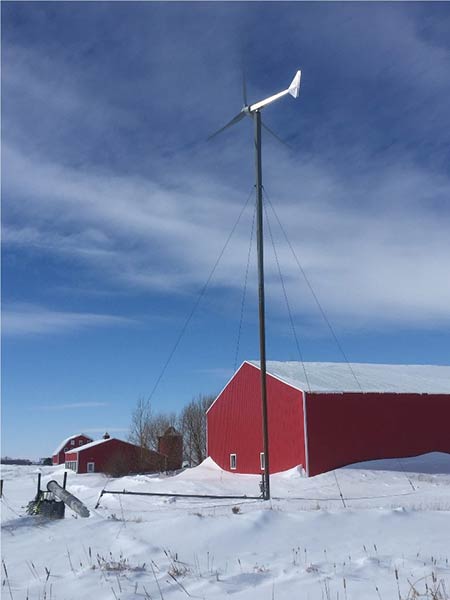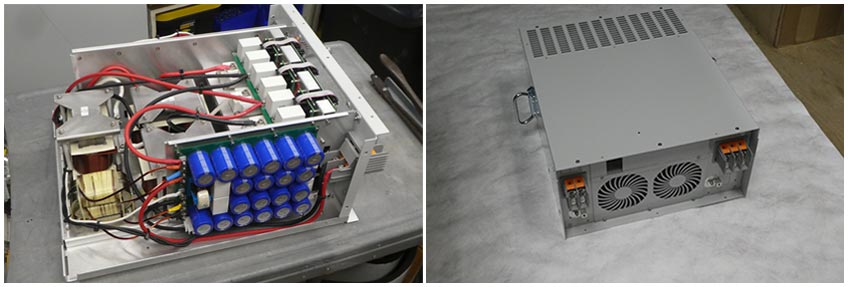NREL Invites U.S. Manufacturers To Partner on Distributed Wind Technology Innovation
The National Renewable Energy Laboratory (NREL) has issued a request for proposals (RFP) for the U.S. Department of Energy (DOE) Competitiveness Improvement Project (CIP) for distributed wind. The application deadline is Feb. 26, 2021.
Distributed wind projects, which produce electricity on-site or locally, offer many benefits for businesses and consumers interested in producing their own electricity, including lower energy costs and a more secure, resilient power system. However, many companies that build the small- and medium-sized wind turbines typical of distributed wind projects do not have the resources to develop and certify next-generation technology.
That is where the CIP can help. Managed by NREL on behalf of DOE’s Wind Energy Technologies Office, the CIP periodically awards U.S. manufacturers of small- and medium-sized wind turbines and components cost-shared subcontracts via a competitive process. Designed to help awardees optimize their designs, develop advanced manufacturing processes, and perform turbine testing, the CIP’s goals are to make wind energy cost competitive with other distributed generation technologies and increase the number of wind turbine designs certified to national testing standards.

The DOE Competitiveness Improvement Project (CIP) provides financial and technical support that enables small U.S. wind manufacturers to develop innovative distributed wind technology like the Bergey Excel 15 wind turbine (shown here), which reduces energy costs 50% compared to older models. Photo courtesy of Bergey Windpower
“Distributed wind shows tremendous potential as a renewable, affordable energy resource that can help our nation reach its clean energy goals with domestic energy technology,” said Ian Baring-Gould, NREL’s distributed wind energy program lead. “The CIP not only helps small businesses and manufacturers turn their ideas into reality, but this innovative program also provides the opportunity for businesses and homeowners in rural America who have a wind resource to tap into local, low-cost, clean, and resilient energy solutions.”
One example of the impact the CIP is making on U.S. distributed wind and small businesses is Intergrid LLC, which developed a power inverter for wind turbines under 25 kilowatts (kW) to meet updated grid integration requirements, while adding storage capabilities for resilient back-up power. Inverters change the variable power produced by a wind turbine’s generator into power that can be used by homes and businesses or supplied onto the grid.
Though the expanding market for solar power has resulted in technical advancements for solar power inverters, significant differences in the technical requirements between wind and solar technologies make solar inverters difficult to use with distributed wind systems. The Intergrid inverter—which is expected to be manufactured by Matric Limited of Seneca, Pennsylvania, under a 2020 CIP manufacturing innovation award—fills a gap in the distributed wind industry by delivering an interconnection-code-compliant inverter designed for use with wind technology that is compatible with other distributed energy technologies.
“Thanks to funding from the CIP, we were able to design and develop Intergrid’s concept of an inverter that will work with any wind turbine up to 25 kW,” said Intergrid President Robert Wills. “When available, our inverter will be the only such product on the market—and will fill a huge need of small wind-turbine manufacturers in the United States and around the world.”

Intergrid LLC developed this power inverter for 25-kW wind systems with funding from the CIP. Photos by Robert Wills, Intergrid LLC
Since 2012, NREL has awarded 44 subcontracts to 23 companies under the CIP, totaling $10.62 million of DOE funding and leveraging $5.41 million in additional private-sector investment. Beyond funding support, awardees can receive technical assistance from NREL to improve their turbine designs and testing plans. The CIP fact sheet provides additional information about awardees and a research-area funding breakdown.
This latest RFP focuses on projects that:
- Develop new, innovative distributed wind concepts
- Transform and optimize existing designs for lower cost, increased energy production, or expanded capabilities, such as advanced grid support to enhance power system resiliency
- Conduct turbine and component testing to national standards to verify performance and safety
- Develop advanced manufacturing processes to reduce hardware costs.
The CIP is designed to accommodate small businesses in different phases of the product development process—from pre-prototype paper design through commercial test unit. Companies are encouraged to apply to the topic area that best aligns with their technology readiness.
Small businesses selected for awards undertake projects that enable wind technology as a distributed energy resource, help make distributed wind cost competitive, improve its interoperability with other distributed energy resources, and increase the number of small- and medium-sized wind turbine designs certified to national and international standards.
In December, NREL hosted a virtual workshop to provide an overview of the CIP, including evaluation criteria, certification requirements, and NREL’s technical support opportunities for those interested in applying to CIP solicitations. Read the presentations from last year’s workshop for examples of past projects and to learn tips for preparing successful proposals and reports.
Last Updated May 28, 2025
